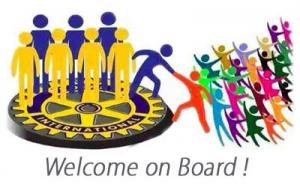Club Meeting - Dachau concentration camp.
Wed, Apr 3rd 2024 at 6:00 pm - 7:30 pm
Jack Hunter

Jack and Frances travelled to Germany for the Munich Christmas Market last December. Their son and daughter in law were to join them a day later so, with a day to spare, Jack and Frances took a guided tour of Dachau. Their guide, who had been in the role for 13/14 years, had visited many other camps in Austria, Germany and Poland, learning from survivors and relatives the more personal experiences of this very dark time in history.
Dachau was one of the first concentration camps, and the longest running one, built by Nazi Germany. We were all surprised to hear the camp, opened in 1933, had not closed until 1960. Although the war finished in 1945 the camp was used to house 18000 SS members and 12000 others, including Russian deserters, awaiting trials. It also served as a US military base until it closed in 1960.
Hitler wanted the camp close to his HQ in Munich to house his political opponents. Situated some 10 miles north-west of Munich, on the site of a World War 1 munitions factory, it was part of his plan to become a dictator, ridding himself of those who threatened this desire. In February 1933 a Dutch communist was caught setting fire to the parliament building (Reichstag). Hitler used this to persuade the President (Hindenburg) to pass an emergency law restricting personal liberty. Again, to aid his aim, it allowed him to imprison his communist opponents. Following this was the Enabling Act banning communist deputies and the SA (Sturmabteilung - Storm Division/Troopers also known as Brown Shirts). His relentless march continued with the Reichstag passing a law giving Hitler the right to make laws without their approval for four years (giving him the power to quash all opposition parties), followed by the banning of all political parties, other than the Nazi party, in July 1933. In 1934 Hindenburg died and Hitler became Fuhrer in his stead. The scene was set……
Dachau, opened by Himmler in 1933, was subsequently enlarged to accommodate forced labourers and, as we know, later the imprisonment of Jews, Romani, criminals and foreign nationals from countries Germany had occupied or invaded. Prisoners were forced to go out each day to help build the local infrastructure e.g. roads for the benefit of the Nazis. All were escorted by guards to their place of work with the exception of Jehovah’s Witnesses. Jehovah’s Witnesses believed their internment was a test from God which they had to pass and, therefore, were not an escape risk for the Nazis.
The entrance gate to Dachau is not the original - it was stolen by a Swedish Neo-Nazi and found three years later in Bergen, Norway, in 2017. The sign above the gate will be recognised by many -
Arbeit Macht Frei (Work shall set you free). The original is back in Dachau but is in the main exhibition hut, protected by alarms. Visitors to the camp are not allowed to eat and can only drink water. Filming of guides talking is not allowed as Holocaust deniers will dub over this creating their own narratives.
Not only the entrance gate has been stolen, over time, but old door handles and fake shower heads have disappeared. Jack showed several photographs of the different buildings; many of the original
buildings, made of wood, no longer exist. Evidence of the two metre wide trench and electric fence, surrounding the camp, can be seen in places. It was snowing when Jack and Frances were there making the visit more poignant. Impossible to imagine what prisoners endured during their time, the conditions did allow reflection on what it must have been like to stand there (as a prisoner), maybe without shoes, and certainly without coats, for long periods of time for roll call at the beginning and end of each working day. We saw photographs of the sleeping arrangements, of three-tiered bunking - wooden slats were covered in straw for bedding. There were lots of camps in the area with Dachau being the main one - workers were moved around from all camps to ensure the work was completed. Dachau was also a training centre for personnel for the other camps. We also saw photographs of the crematorium and were told the shower rooms were situated to the side. Fake shower heads belied the purpose of the showers. Zyklon B was the gas of choice (hydrogen cyanide). Zyklon B pellets required a certain temperature for the pellets to vaporise, so showers were heated for this purpose. Allegedly guards complained about hearing the screaming of the dying prisoners - the pellets were, therefore, poured in earlier (when conditions were cooler) and the heat increased, giving time for the guards to get further away before the gas began to work its wicked way.
We took a look at daily life in the camp and learnt the prisoners, clad in striped pyjama-like garb, were classed as untermenschen, meaning sub-man or subhuman. They had to look at the ground and not the guards in the eye and were not allowed to put their hands in the pockets of their trousers - failure to comply resulted in the prisoner being shot. Each day began with a roll call before prisoners went out to the fields and factories to work and ended with another roll call to ensure everyone was accounted for. During the summer, windows in the huts were kept closed so temperatures inside were stifling whereas in winter windows were kept open and there was no heating……. One meal a day consisted of a watery vegetable soup and a piece of bread. Useful prisoners who had kitchen, book-keeping and accounting skills, for example, often fared better as they were needed by the Germans.
Each prisoner was given a number which was tattooed on a forearm. At the end of the war some prisoners forgot their names, so used were they to knowing and answering to a number. If you don’t know your name you cannot open a bank account…… Coloured badges were worn by prisoners so they could be identified by their crime.
l Red badges - political prisoners
l Green badges - professional prisoners
l Black badges - work shy
l Violet badges - Jehovah’s Witnesses
l Pink badges - homosexuals
l Yellow triangle - Jews (a yellow star was a product of films and not reality)
l Black triangle - Romani
After Kristallnacht (The Night of Broken Glass), 30000 male Jews were sent to concentration camps with about 10000 going to Dachau. The exact number of those who died there is unknown but we know it exceeds 25000. Conditions were so bad deaths resulted from disease, malnutrition and suicide as well as the intended deaths. There was a typhus epidemic in 1944 which killed more than 15000. An intake of 206,206 prisoners were recorded in the 12 years Dachau was a concentration camp……
Just days before US troops arrived at the camp, in April 1945, 6 to 7000 prisoners were forced on a 6 day death march to Eurasburg. Those who couldn’t keep up were shot, many died from exhaustion,
hunger and exposure; a mass grave of 1000 plus was found along the march route. US troops shot some of the German guards during the liberation of the camp. Numbers are not confirmed but it was thought between 30 and 50; prisoners killed a similar number. Closed in 1960 the Dachau Concentration Camp Memorial site was opened to the public in 1965.
Jack told us the mood of the visitors was sombre, made more so by the snowy, quiet and still conditions. There was a lot to see and a lot to listen to and learn - the guide was brilliant. Prisoners were mostly adults as they were needed to do the work to support the Nazi activities. Robin told us the hunt for war criminals is still on-going aided by the comprehensive records kept by the Nazi regime.
 Contact Jack Hunter about this page:
Contact Jack Hunter about this page:
'What We Do' Main Pages:
.jpg)
.The club undertakes a varied and active involvement with environmental projects - See below for the Next working party dates....
moreLocated on the A5199 Welford Road, between Foston Rd and Arnesby, The entrance location ///crew.broad.branch. SEE DETAILS BELOW...
more
All bids should be sent by email to the following address.... mistertfox@gmail.com Closing date for submitting your BID is MIDNIGHT 18th DECEMBER
more




